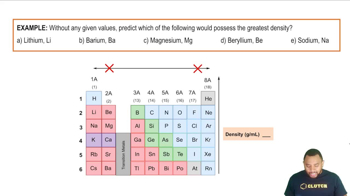Ch.22 - Chemistry of the Nonmetals
Chapter 22, Problem 71
Complete the exercises below. Select the member of group 4A that best fits each description: a. has the lowest first ionization energy, b. is found in oxidation states ranging from -4 to +4, c. is most abundant in Earth’s crust.
 Verified step by step guidance
Verified step by step guidance1
Step 1: Identify the elements in group 4A of the periodic table. These elements are carbon (C), silicon (Si), germanium (Ge), tin (Sn), and lead (Pb).
Step 2: To determine which element has the lowest first ionization energy, recall that ionization energy generally decreases as you move down a group in the periodic table. Consider the position of each element in group 4A.
Step 3: For the element that is found in oxidation states ranging from -4 to +4, consider the typical oxidation states of each group 4A element. Remember that carbon is known for having a wide range of oxidation states.
Step 4: To find the most abundant element in Earth's crust from group 4A, consider the natural abundance of each element. Silicon is well-known for being a major component of the Earth's crust.
Step 5: Review your answers by comparing the properties of each group 4A element to ensure they match the descriptions given in the problem.
Key Concepts
Here are the essential concepts you must grasp in order to answer the question correctly.
Group 4A Elements
Group 4A, also known as Group 14 in the periodic table, includes elements like carbon (C), silicon (Si), germanium (Ge), tin (Sn), and lead (Pb). These elements exhibit a range of oxidation states and are known for their ability to form covalent bonds. Understanding their properties, such as ionization energy and common oxidation states, is crucial for identifying the correct element based on the given descriptions.
Recommended video:
Guided course

Main Group Elements: Density Example
Ionization Energy
Ionization energy is the energy required to remove an electron from an atom in its gaseous state. Elements in Group 4A show varying ionization energies, with heavier elements generally having lower ionization energies due to increased electron shielding and distance from the nucleus. This concept is essential for determining which element has the lowest first ionization energy among the group.
Recommended video:
Guided course

Ionization Energy
Oxidation States
Oxidation states indicate the degree of oxidation of an atom in a compound, reflecting the number of electrons lost, gained, or shared. In Group 4A, elements can exhibit multiple oxidation states, typically ranging from -4 to +4. Recognizing these states helps in identifying the element that fits the description of having a range of oxidation states, which is particularly relevant for elements like carbon and silicon.
Recommended video:
Guided course

Oxidation Numbers
Related Practice
